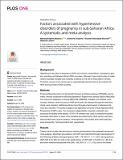Factors Associated with Hypertensive Disorders of Pregnancy in sub-Saharan Africa A systematic and meta-analysis
View/
Publication Date
2020-08-19Type
Article, Journalviews
downloads
Metadata
Show full item recordCitation
Meazaw MW, Chojenta C, Muluneh MD, Loxton D (2020) Factors associated with hypertensive disorders of pregnancy in sub- Saharan Africa: A systematic and meta-analysis. PLoS ONE 15(8): e0237476. https://doi.org/ 10.1371/journal.pone.0237476
Abstract/
Background Hypertensive disorders of pregnancy (HDP) are common complications of pregnancy globally, including sub-Saharan African (SSA) countries. Although it has a high burden of maternal and neonatal mortality and morbidity, evidence on the risk of the problem is limited. Therefore, the aim of this review was to systematically examine factors associated with HDP among women in SSA countries. Methods Preferred Reporting Items for Systematic Reviews and Meta-Analyses (PRISMA) was followed. Articles conducted in SSA and published in English from January 2000 to May 2020 from electronic databases including MEDLINE, EMBASE, PubMed, and CINAHL were included. Articles, which focused on HDP and found to be relevant through the reference check, were included. Additional articles found through a hand search of reference lists were also included. The quality of papers was appraised using the Critical Appraisal Skills Programme (CASP) scale. Two reviewers independently screened, extracted, and assessed the quality of the articles. STATA 16 software was used to compute the pooled estimated odds ratios for each of the identified associated factor. Both random and fixed effect models were used for analysis. Heterogeneity of the studies and small study bias were checked by I2 and asymmetric test, respectively. Results Twenty-seven studies met the inclusion criteria and included in the systematic review and meta-analysis. Significant associations with HDP were identified through meta-analysis for the following variables: being primiparous (OR: 1.78; 95% CI: 1.11, 2.44), having previous HDP (OR: 3.75; 95% CI: 2.05, 5.45), family history of HDP (OR: 2.73; 95% CI: 1.85, 3.6), and lower maternal educational level (OR: 1.65; 95% CI: 1.17, 2.13). Due to the limited number of studies found specific to each variable, there was inconclusive evidence for a relationship with a number of factors, such as maternal nutrition, antenatal care visits, birth spacing, multiple birth, physical activity during pregnancy, use of contraceptives, place of residency, family size, and other related associated factors. Conclusions The risk of developing HDP is worse among women who have a history of HDP (either themselves or their family), are primiparous, or have a lower maternal educational level. Therefore, investment in women’s health needs considered to reduce the problem, and health service providers need to give due attention to women with at increased risk to HDP. Additionally, interventions need to focus on increasing women’s access to education and their awareness of potential associated factors for HDP.
Subject/
Hypertensive disorders of pregnancy (HDP; Maternal and neonatal mortality and morbidity; Preferred Reporting Items for Systematic Reviews and Meta-Analyses (PRISMA); Critical Appraisal Skills Programme (CASP); MEDLINE, EMBASE, PubMed, and CINAHL; Maternal nutrition; Antenatal care visits; Birth spacing; Multiple birth; Physical activity during pregnancy; Contraceptives; Place of residency; Family size
Further Details
Copyright: © 2020 Meazaw et al. This is an open access article distributed under the terms of the Creative Commons Attribution License, which permits unrestricted use, distribution, and reproduction in any medium, provided the original author and source are credited. Data Availability Statement: All relevant data are within the paper and its Supporting Information files.
Publisher
ResearchGateCollections
- General - GEN [367]

